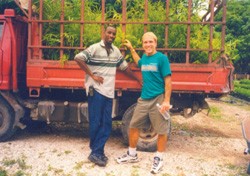
Challenge
Haiti is considered the poorest country in the Western Hemisphere. Decades of political turmoil and high levels of poverty have contributed to environmental degradation resulting in extreme depletion of Haiti’s natural resources. The task of restoring native ecosystems, preserving soil nutrients for future crops, and decreasing erosion to improve farming life for Haitians is critical.
Initiative
USAID’s Farmer to Farmer program, implemented by Partners of the Americas, has been working for many years to address these and other agricultural issues. Bamboo, which grows rapidly and has multiple applications, is ideal to help with these needs. Bamboo can be used as construction material, to stabilize stream banks, and for traditional arts and crafts, an industry in which there is growing interest on the part of small-scale farmers.
Farmer to Farmer volunteer Norm Bezona, a bamboo expert, has traveled to Haiti four times. Bezona represents the best of how volunteers meet the challenges of protecting Haiti’s ecosystem. Bezona’s project was completed in two phases. The introduction and propagation of new species, and education of farmers regarding multiple benefits of bamboo was the first phase. Then, an expansion was developed to include additional agricultural groups in other regions and distribution of the plants to individual farmers and collaborating groups for nursery and communal reforestation projects. On his first trip, Bezona delivered 200 plants representing twelve bamboo varieties. These plants were donated by the Quindembo Nursery in Hawaii.
Results
After four months, the donated plants were doing better in Haiti than in their native Hawaii. Techniques such as root division and branch cuttings have since generated over 40,000 plants from the original 200. Fifteen thousand bamboo plants have already been distributed throughout the country. Two hundred plants have also been brought to the Asociacion de Paysans de Vallue (APV) in the south, where staff members were trained on the propagation and use of bamboo. In the Camp Perrin area, USAID has helped in efforts to distribute plants to individual farmers. Of the 2,000 farmers who received plants, most farm one to two hectares of land and have planted 50% of the bamboo plants for construction, 25% for crafts and 25% for erosion control and reforestation.







Comment
Make a general inquiry or suggest an improvement.